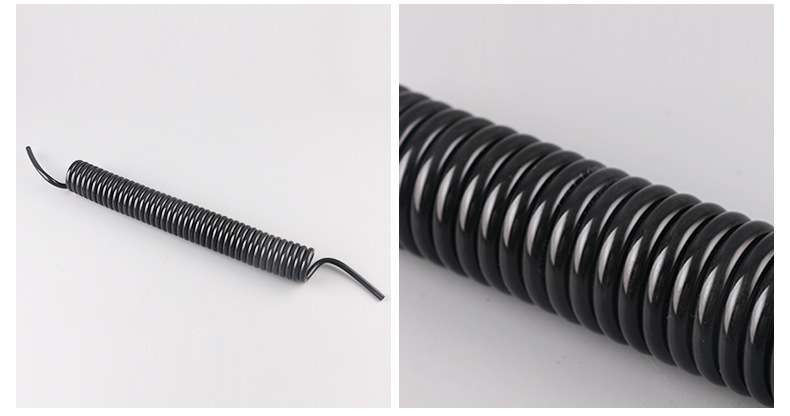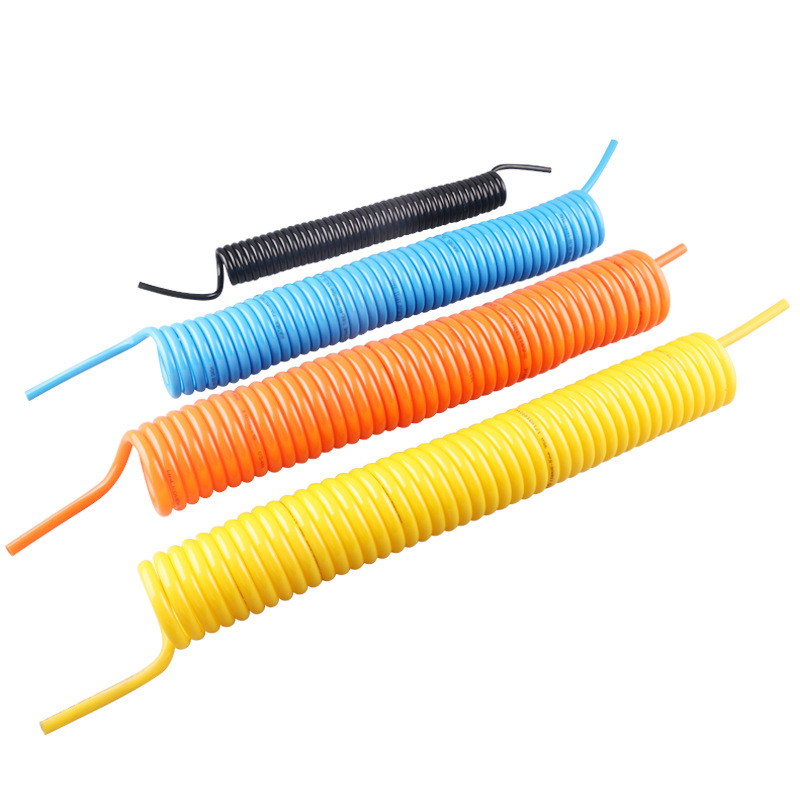Polyurethane recoil hoses are essential components in various pneumatic applications, known for their unique properties that enhance flexibility, durability, and ease of use. These hoses are designed to return to their original shape after being stretched or compressed, making them ideal for environments where movement and space efficiency are critical. In this article, I will provide an in-depth exploration of polyurethane recoil hoses, covering their manufacturing process, benefits, applications, and best practices for selection and maintenance. This comprehensive guide aims to equip you with all the information you need to make informed decisions regarding polyurethane recoil hoses.
Table of Contents
ToggleWhat is a Polyurethane Recoil Hose?
A polyurethane recoil hose is a type of flexible tubing made from polyurethane, a synthetic polymer known for its excellent elasticity and resilience. These hoses are engineered to recoil back to their original length after being extended, which minimizes tangling and kinking during use. This unique characteristic sets polyurethane recoil hoses apart from traditional hoses made of rubber or PVC, which may not offer the same level of flexibility and durability.
Key Characteristics of Polyurethane Recoil Hoses
- Elasticity: Polyurethane recoil hoses can stretch significantly and return to their original shape without permanent deformation, making them ideal for dynamic applications.
- Lightweight: Compared to rubber or PVC hoses, polyurethane hoses are lighter, which enhances portability and reduces user fatigue during prolonged use.
- Durability: These hoses exhibit high resistance to abrasion, chemicals, and UV exposure, allowing them to perform well in harsh environments.
- Temperature Range: Polyurethane hoses can operate effectively across a broad temperature range, typically from -40°F to 180°F (-40°C to 82°C), making them suitable for various climates and conditions.

What Are the Key Benefits of Using Polyurethane Recoil Hoses?
Polyurethane recoil hoses offer several advantages that make them a preferred choice in many applications:
1. Flexibility and Recoil Properties
The inherent flexibility of polyurethane allows these hoses to bend and twist without kinking, which is essential in dynamic environments where movement is frequent. Their recoil properties mean that they can retract to a compact size when not in use, reducing clutter and improving organization.
2. Lightweight Design
The lightweight nature of polyurethane recoil hoses makes them easier to handle and maneuver. This is particularly beneficial in applications where hoses are frequently moved or repositioned, as it reduces operator fatigue and enhances productivity.
3. Resistance to Abrasion and Chemicals
Polyurethane is known for its excellent resistance to abrasion and a wide range of chemicals. This makes polyurethane recoil hoses suitable for use in harsh environments, including construction sites and industrial applications where exposure to chemicals is common.
4. Temperature Tolerance
Polyurethane hoses can withstand a wide range of temperatures, making them versatile for various applications. Their ability to maintain performance in extreme conditions ensures reliability in both hot and cold environments.

How is Polyurethane Recoil Hose Manufactured?
The manufacturing process of polyurethane recoil hoses involves several key steps, each critical for ensuring the final product meets quality and performance standards.
1. Material Selection and Formulation
The first step in manufacturing polyurethane recoil hoses is selecting the appropriate polyurethane formulation. Different formulations can be tailored to achieve specific properties, such as flexibility, hardness, and chemical resistance. The choice of formulation directly impacts the hose’s performance characteristics.
2. Extrusion Process
Once the material is prepared, it undergoes the extrusion process. In this phase, the polyurethane is heated and forced through a die to create a continuous tube. The extrusion process is crucial as it determines the hose’s diameter, wall thickness, and overall consistency. Advanced extrusion techniques ensure that the tubing is uniform and free from defects.
During extrusion, the material is heated to a specific temperature that allows it to flow easily through the die. The die shape determines the final profile of the tubing, and careful control of the extrusion speed and temperature is essential to maintain the desired properties of the hose.
3. Coiling and Quality Control
After extrusion, the hose is cooled and coiled for storage and transport. Quality control measures are implemented throughout the manufacturing process, including in-process inspections and final product testing. These tests assess flexibility, pressure resistance, and durability to ensure the hose meets industry standards.
Quality control is vital to ensure that the hoses perform reliably in their intended applications. Manufacturers often conduct tests to evaluate the hose’s ability to withstand pressure, its flexibility under various conditions, and its resistance to wear and tear.
What Are the Common Applications of Polyurethane Recoil Hoses?
Polyurethane recoil hoses are utilized across various industries due to their versatility and performance characteristics. Here are some common applications:
1. Automotive
In the automotive industry, polyurethane recoil hoses are used for air and fluid transfer in pneumatic tools, providing reliable performance in workshops and assembly lines. Their flexibility allows for easy maneuvering around equipment and vehicles.
2. Construction
Construction sites often require hoses that can withstand harsh conditions. Polyurethane recoil hoses are ideal for powering pneumatic tools and equipment, thanks to their durability and resistance to abrasion. They can handle the rigors of outdoor use while maintaining performance.
3. Manufacturing
In manufacturing settings, these hoses are used for material handling and fluid transfer, ensuring efficient operation in automated systems. Their lightweight design and flexibility make them suitable for use in conveyor systems and robotic applications.
4. Agriculture
Polyurethane recoil hoses are also used in agricultural applications for irrigation and chemical spraying, where flexibility and chemical resistance are essential. Their ability to recoil helps keep work areas organized and free from tangles.

How to Choose the Right Polyurethane Recoil Hose for Your Needs?
Selecting the right polyurethane recoil hose involves considering several critical factors:
1. Diameter and Length Requirements
Determine the appropriate diameter and length based on your specific application. Ensure that the hose can accommodate the required flow rates and pressure levels. A hose that is too small may restrict flow, while one that is too large may be cumbersome to handle.
2. Pressure Ratings and Temperature Tolerances
Check the pressure ratings and temperature tolerances of the hose to ensure it can handle the specific conditions of your application. Exceeding these ratings can lead to failures and safety hazards. Always refer to the manufacturer’s specifications for guidance.
3. Compatibility with Fluids and Air
Ensure that the polyurethane material is compatible with the fluids or air it will carry. This is crucial for maintaining the integrity of the hose and preventing degradation. If you are unsure, consult the manufacturer for compatibility information.
What Are the Common Issues and Troubleshooting Tips for Polyurethane Recoil Hoses?
While polyurethane recoil hoses are durable, they can encounter some common issues. Here are a few potential problems and troubleshooting tips:
1. Kinking
Kinking can occur if the hose is bent beyond its minimum bend radius. To prevent this, always follow the manufacturer’s specifications regarding bend radius and avoid sharp turns during installation. Using proper fittings can also help maintain the hose’s integrity.
2. Abrasion
Although polyurethane is resistant to abrasion, prolonged exposure to rough surfaces can still cause wear. Regularly inspect the hose for signs of damage and replace it if necessary. Using protective sleeves or guards can help extend the hose’s lifespan.
3. Leaking
Leaks can occur at connection points or due to damage in the hose. Ensure that all fittings are secure and check for any signs of wear or damage regularly. Implementing routine maintenance checks can help identify potential leaks before they become significant issues.

How to Properly Install and Maintain Polyurethane Recoil Hoses?
Proper installation and maintenance are key to ensuring the longevity and performance of your polyurethane recoil hoses:
Installation Tips
- Use the Appropriate Fittings: Ensure that the fittings you use are compatible with your hose type. Mismatched fittings can lead to leaks and system failures.
- Avoid Sharp Bends and Kinks: During installation, take care to avoid sharp bends and kinks in the hose. This will help maintain optimal airflow and prevent damage.
- Cut Hose Cleanly: Ensure that the hose is cut cleanly and squarely to avoid leaks at the fittings. Using a proper hose cutter can help achieve a clean cut.
Maintenance Practices
- Regular Inspections: Regularly inspect hoses for signs of wear, kinks, or leaks. Early detection of issues can prevent more significant problems down the line.
- Clean the Hose: Clean the hose as needed, especially if it is exposed to dust or debris. This will help maintain optimal airflow and prevent blockages.
- Replace Damaged Hoses: Replace any damaged hoses immediately to prevent system failures. Keeping spare hoses on hand can help minimize downtime.
Conclusion
Polyurethane recoil hoses are an excellent choice for a wide range of applications due to their flexibility, durability, and ease of use. By understanding the manufacturing process, benefits, and best practices for selection and maintenance, you can ensure that you choose the right hose for your specific needs. Whether you’re in automotive, construction, or manufacturing, polyurethane recoil hoses can enhance efficiency and reliability in your operations.
If you have any questions or need expert advice on selecting the right polyurethane recoil hose, feel free to reach out. Your success in utilizing these hoses depends on the choices you make today!

